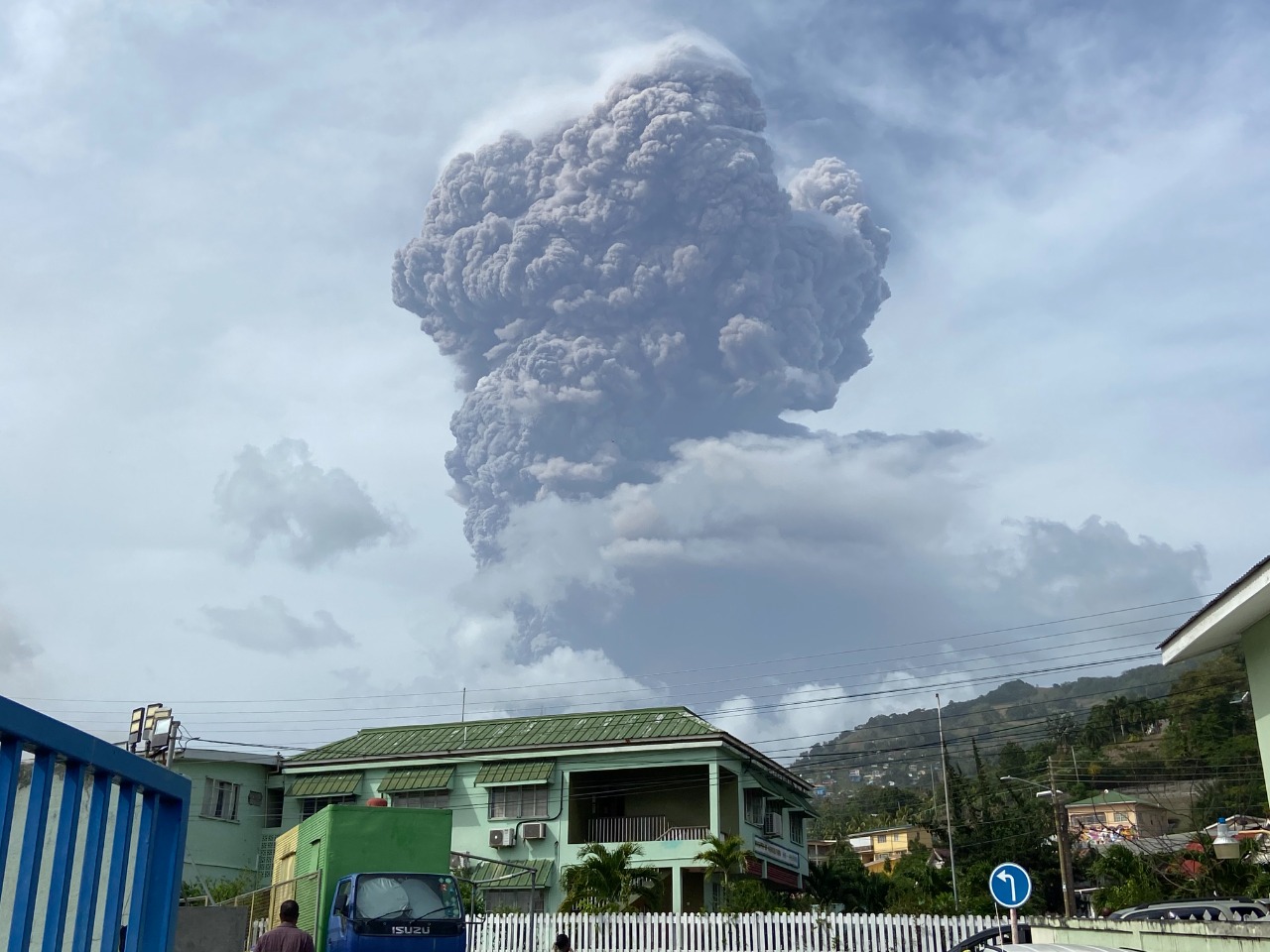KINGSTOWN, St Vincent
Leaning against the concrete wash sink in his yard, still wearing his farm attire, Lloyd Ballantyne considers the head of cabbage in his hand. “The crop wasn’t bad, but the Soufrière bad up the crop,” he mutters as he peels away the outer, ash-stained leaves to reveal the greenish white vegetable.
“I just have to wash off that,” he continues as he places the vegetable under the tap and scrubs it gently with his hands.
“Right. You see, this is ready to market now,” he says as he cuts off the stem with a deft move of his knife, his smile broadening, revealing a golden tooth.
It is near 6 p.m. on April 21, in Stubbs – nine miles east of here, the end of a long day, which, for Ballantyne, began in Fancy, the northernmost village in this country.
By land, it would have taken Ballantyne about 90 minutes to travel the 26 miles from his farm in Fancy to his home in Stubbs.
However, today, he was forced to take a long route, travelling 17 nautical miles on a fishing boat from Fancy to Kingstown – a journey that gave him an uncomfortable front row seat to an explosion of the erupting La Soufrière volcano.
After the unnerving boat ride, Ballantyne then had to wait a few hours in Kingstown before he could get transportation home. A minivan would have gladly accepted the extra dollars that the sacks of cabbages would have attracted for the seats they occupy.
Transporting three goats – two of which were fully grown rams – is, however, out of the question. The sacks of cabbage that Ballantyne is cleaning in his yard are about all the produce he has salvaged from his farm after the April 9 explosive eruption of La Soufrière, which occupies the northern third of this 133 square mile island.
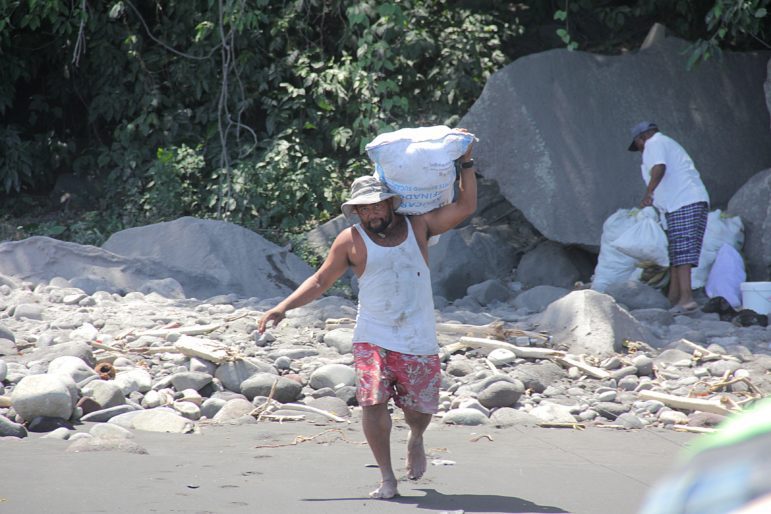
Interview: Lloyd Ballantyne
“It (the eruption) crashed the farm. Nothing is on the farm right now,” Ballantyne says.
“What you see us trying to clean up here is just the remainder that we can get to harvest: cabbage and sweet pepper,” he continues, adding that he could not put a value on the amount he lost.
Ballantyne, one of the largest farmers in Fancy, had planted over 7,000 heads of cabbage this season. The first yield, harvested one week before the eruption, was 82lbs and earned him, EC$246 (US$92).
It was an encouraging start to the harvest season. However, since erupting, La Soufrière has spewed over a foot of ash on most of the northern third of St Vincent.
The once green agricultural communities are now a hazy whitish grey, and, in some places, the ash on the ground is still hot to the touch amidst blistering sunshine, days after the last significant ash fall.
“Everything is down. I had peanuts to harvest at the end of this month. The ash just covered everything. If you have to reap, you have to get a hoe and try to scramble up some,” Ballantyne explains.
Fancy is the closest village to La Soufrière, and Ballantyne was on his way to the market in Kingstown when the volcano erupted.
With the evacuation order having been given 15 hours earlier, it was not until April 18 – Day 10 of the eruption – that he was able to return to his farm.
He is forced to travel by boat, as the road between Fancy and the rest of the country sustained substantial damage, and huge boulders now stand where vehicles once traversed.
“The ash on the produce has become really tough, especially as Fancy is getting some rain,” he says.
“You make up your mind that that is a loss; that is the volcano crop. All those crops, you give them to the volcano,” Ballantyne adds.
The volcanic ash has burnt holes in the sweet peppers, which were almost ready for market. The peanuts, on the other hand, are mushy, having boiled underground.
“Everything, you just have to call it a volcano crop,” Ballantyne repeats, as if consoling himself.
He will have to share the peppers among his friends. They can be consumed but are not fit for sale. “Well, the cabbage, I am doing my best to see if I can make back my seed money. I can’t make back my money that I spent but I can still own a pack of seeds. I don’t know how long this thing will last so I have to prepare for the wet days still.”
And Ballantyne is well advised in his approach.
After four decades of inactivity since its 1979 eruption, La Soufrière suddenly began oozing magma last December, before erupting explosively in April.
Geologist Professor Richard Robertson, the lead scientist monitoring the volcano, says that the eruption could go on for up to a year.
Ballantyne also has 17 goats and seven pigs on the farm. Two of the pigs are pregnant, and another has three piglets. They all survived, though at the expense of other farmers. “The potatoes, they live in there,” he says, referring to the fact that with the community covered in ash, livestock in the village are eating what is left of farm crops.
“There are no crops in Fancy where people can say they are going back to Fancy and start there. They have to start all over again because all the potatoes, all the eddoes, the animals live in them. Nothing for people right now.” Ballantyne heaves a heavy sigh at the prospect of starting afresh.
“I would need real serious assistance. This is start over when it comes to the crops – not with the pigs – but the pigs need help also, because right now there is no road to go into Fancy.”
When he left Fancy on Thursday, Ballantyne left some mill feed for the pigs and the animals know where to get water. But, with the road impassable and access to the Red Zone controlled by police, he is not sure when next he can return to the farm.
The boat trip cost him EC$200 (US$75), about four times what he would have paid to transport the sacks of cabbages and the three goats by land.
A government donation of feed for his pig will go a long way, Ballantyne says.
Reduced to Tears
Meanwhile, fellow Fancy resident, Kay Bowens, who is also a farmer, was reduced to tears when she returned to her village on April 21 – Day 13 of the eruption, her first visit in a month, having evacuated two weeks before the eruption.
“I plant sweet potatoes, eddoes, groundnuts and also tannia. Because of the stuff that fell, the ash and the sulphur that fell, I would say that it destroyed it. So, I lost everything,” she says. Bowens’ loss is substantial. She had paid EC$260 (U$97) to clear the land to plant the peanut.
“I had to pay to dig (plough) it and I eventually had to pay for weeding it. And the potato as well, I paid a lot of money. I can’t say how much I lost because it is a lot.”
Bowens was anticipating a yield of three sacks of peanuts, or about 600lbs in total.
“And you know peanut is money – $10 a pound,” she says, adding that sweet potatoes sell for at least $100 a sack.
Bowens has a 15-year-old son who is in Form 4 at the North Union Secondary School and the money from her farm is “very important” to her household and her son’s education.
“When I came into the house, I cried. All I said to myself that where there is life there is hope, but I am still wondering if I will be discouraged from going to plant because of the soil. What happened in Fancy, it’s like a desert to me,” Bowens says.
Interview: Kay Bowens
‘Agriculture is shot through, completely’
The farmers’ accounts are testament to the report by Minister of Agriculture Saboto Caesar during a tour of the northeast on April 17, one day after his ministry conducted a preliminary assessment.
“We visited the windward side of the Red Zone and basically we have to start over in every commodity area from zero,” the minister says. “We noticed that as it relates to the impact on vegetable production, basically, it’s all wiped out. From the standpoint of livestock, if you notice coming up you will see animals in different areas,” he says, referring to the carcasses of livestock that succumbed during and after the erosion.
“And, right now, we are looking to move some of the animals out of the Red Zone into areas we had secured. The government has significant numbers of livestock in the Red Zone, but we are able to feed them on a daily basis and bring water to then on a day-to-day basis.”
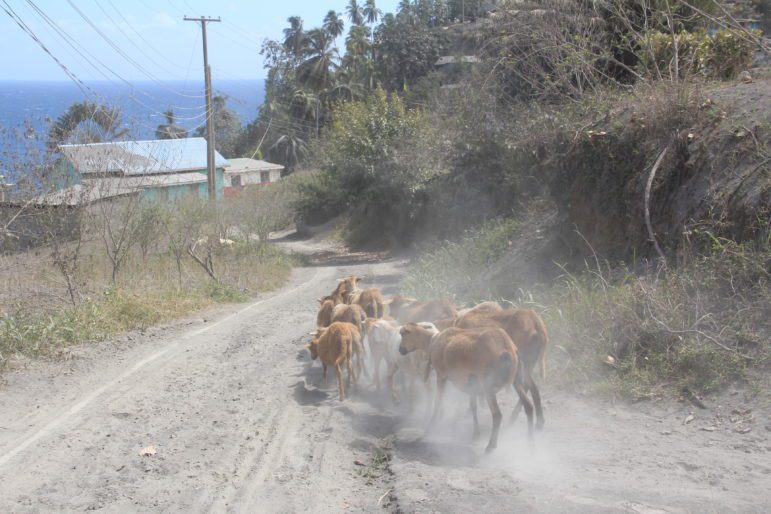
The minister concluded that 100% of agriculture in the Red Zone is lost and about 75% in Orange Zones, the two areas closest to the volcano, which, coincidentally, are the areas in which the most farming is done.
“If you notice the impact on the bananas and the plantains, it has almost gone to zero…” he says.
During the same tour, Prime Minister Ralph Gonsalves said that while his government has not begun to calculate the value of the damage caused by the eruption, “there are hundreds of millions of dollars of assets at risk” in the Red Zone on both sides of the island.
“Agriculture is shot through, completely. There is nothing there. Trees are being denuded – breadfruit, coconut, fruits trees, then other forms of fruits and vegetables are covered; yams, dasheen, tannias, root crop of one kind or another, those are covered over in ash.
“A lot of animals, as you go further north, have died…” the prime minister says.
Gonsalves says that in the north of the country, it could take 10 months to a year, before farmers harvest short crops, even as he noted that tree crops will take longer.
Livestock, Livelihoods Scorched or Washed Away
Two miles south of Fancy, the village of Owia looks even more like a desert, having been robbed of much more of its green regalia, some of which Fancy was able to retain.
The impact of the volcanic eruption on the economy of Owia is more immediately discernible, as it goes beyond the aggregate of the impact on each farmer.
At the arrowroot factory, heaps and sacks of arrowroot rhizome (plant stems) lay rotting in the immense heat, partly covered by volcanic ash. And even if it were possible to wash the ash from the rhizome and process them into starch, which is used in cosmetology and food, there is no factory in which to process them.
The roof of the factory was among the many in Owia that collapsed under the weight of the volcanic ash.
Grafton “Journey” Caesar, of Owia, a root crop farmer, says the eruption destroyed his crop and the river claimed his flock of sheep. “I had planted about three acres of ginger and the rest in tannia. Since the eruption, everything has gone squash. I had 15 sheep; I lost them too.”
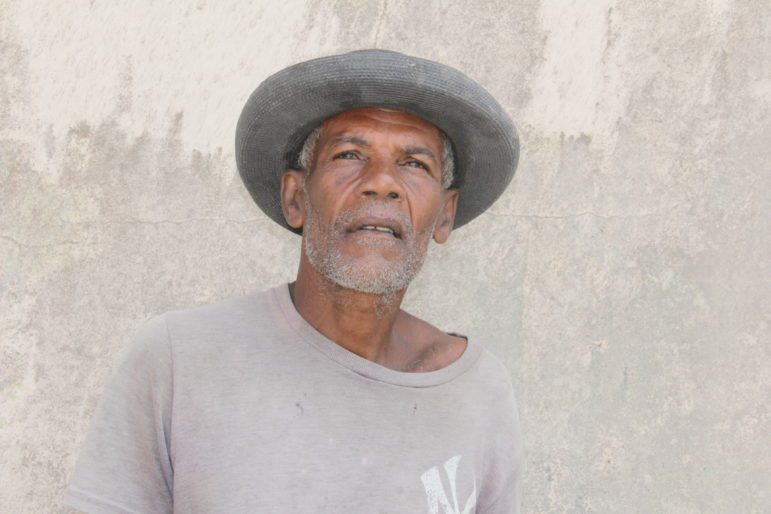
Interview: Grafton Caesar
Caesar was among a handful of residents of Owia who defied the evacuation order – in some instances hiding from police who came to sweep the area for the defiant.
“The reason why I did not evacuate was to take care of my animals. I don’t have it in cash, but I had it in value. God is good. He spared my life, but the animals are gone,” Caesar says.
His farm is in Nippy Hole, an area in the mountains surrounding his village.
He was unable to go to the farm for the first four, most violent days of the eruption.
“When I went, I couldn’t find any of the animals. I rear sheep and when I go, I would call them by name – Rosie, Sandra, Browne Gyal, Lorna. Anytime you call them, they could answer.”
He said that the sheep had sought refuge in caves along the riverside but were washed out to sea by a deluge. “Sheep and goats and pigs, all the pig pens along the riverside were washed away.”
Farming is very important to Caesar’s income. “Traffickers (itinerant traders) would come here, I would dig about 10 sacks of tannia, four bags of eddoes, sweet pepper and ginger – 100lbs of ginger, and most of the ginger, I had just started to harvest them. Most of them are still under the earth, but I had replanted about one acre. “They are now all covered after the volcano.”
Not Enough for Local Consumption or Export
“Traffickers” is the word that Vincentians use for persons who buy agricultural produce locally and sell them across the region – mainly in Barbados, Trinidad and Tobago, and other Caribbean islands.
They mainly trade in plantains as well as root crops, such as sweet potato, dasheens, eddoes, tannia, and ginger. However, they also export fruits, such as bananas, and soursop.
Caesar knows that even if the traffickers come calling with their empty trucks, for the next few months, there will be no farm produce to sell to them.
In turn, their clients and consumers in Port of Spain, Bridgetown and other capitals would have to do without imports or seek alternative markets.
But it is not only the traffickers who are expected to be unable to meet the demands of their customers. The agriculture minister says that food security in St Vincent and the Grenadines is at risk because of the eruption, which has created “a significant need for imports.”
This is echoed in the fears of farmer Caesar in Owia, who is hoping that the ash would not suffocate the ginger he planted four days before the eruption. As with with the other crops, such as sweet potato, what the volcano did not destroy, livestock in the community grazed.
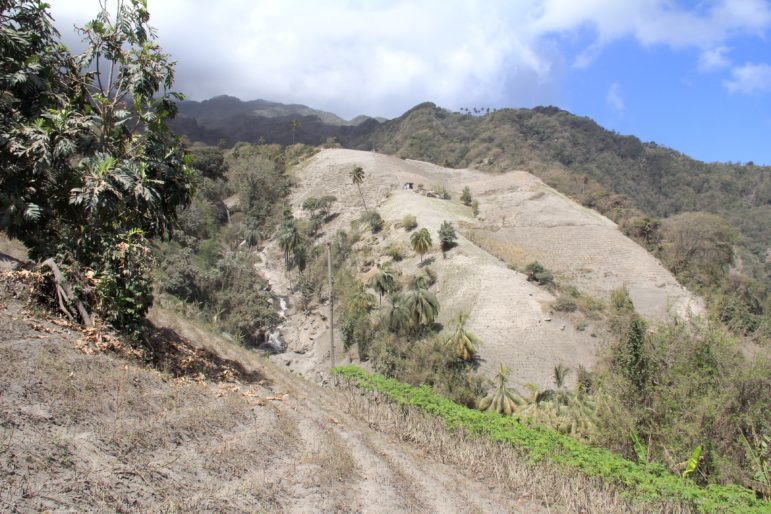
“This place is a rough place and there are mostly poor people living in the area. This is survival. If it were me, I would do the same thing,” he said, referring to the fact that persons who evacuated had to set their livestock loose to increase their chances of survival.
And if Caesar meets any livestock still tethered, he cuts the ropes and sets them loose.
In ordinary times, livestock running loose had caused Caesar’s relationship with some villagers to sour because the animals grazed on his crops.
“The same animal I go to the mountains and set free, those are the same animals that villagers will have to sell to make a dollar to make ends meet,” he explains.
“They are not working, and they depend on the animal they left here. They can come back here – which many of them have done – sell their animals and make a dollar to make ends meet. I think that is a good thing.”
Caesar empathises with villagers who rely on the annual windfall from the arrowroot crop. “Even if you could have saved it (rhizomes), the factory collapsed so they would have spoiled. There are plenty workers that the government employed in the factory and now plenty people lost their jobs. People who were digging arrowroot to make ends meet, things gone squash.”
‘Quite Optimistic’
The impact of the eruption of La Soufrière on agriculture is also being felt in communities further away from the volcano.
On April 18, in Rose Hall, located in the Orange Zone in central-western St Vincent, Obsbert Garraway contemplates the loss on his fruit and vegetable farm.
“A number of my fruit trees were destroyed, broken down – breadfruit, plumose, wax apple. You might see this ash and get the idea that it is fine and so forth. But … the weight of the ash on the leaves actually cause the trees to fall down.”
He uses a forked stick to prod the branches of the fruit trees to shake the ash off and the trees begin to right themselves.
The eruption also destroyed Garraway’s broccoli, purple cabbage, and cauliflower.
“The cabbage just opened and when I went down and saw them, I said, ‘These look like buckets of ash.’ So, I just basically gave up with that.”
INTERVIEW: OSBERT Garraway
While he is a teacher, farming contributes about one-fifth of Garraway’s family’s income, not counting the food from the farm that reaches the family’s dining table.
“As a matter of fact, I don’t know how some people make it, doing a one job as a teacher or a nurse. It is a substantial part – maybe in excess of 20%. And it reduces the amount of money you have to spend on food and so on.”
He says he thinks that the root crops could fare best under the suffocating weight of the volcanic ash. And even as he surveys the fields of Rose Hall, which offer a commanding view of La Soufrière, Garraway is not daunted.
“As a matter of fact, I am quite optimistic. I am looking at the ash as extra fertiliser and basically, we have to see the bright side of things. The volcano is here with us, we can’t move it, we can’t control its actions, and the most we can do is to learn how to live with it,” he says.
“I think every part of the world has its own challenges: California’s wildfires, Australia, they have fireside yearly, some places are hurricane prone. So, if the volcano is our thing, we just have to earn to live with it. That’s how I see it.”
Garraway, like his neighbouring farmer, Lennox Lampkin is among the few farmers that did not evacuate Rose Hall, an Orange Zone community renowned for vegetable cultivation.
Lampkin, an information communication technology specialist, and former teacher, who got into tree crops a decade and a half ago, has a similar outlook as his neighbour.
“I consider Soufrière the womb of St. Vincent. Without it, we would be nowhere. That’s where we were all born. That’s where this country was born because all the aggregate that we use, the fertile soil we have, we thank it to that one. That’s the Mother Nature there that is really regenerating our soils that we have destroyed. So, this process is something that this country has been going through for maybe thousands of years.”
The eruption, he says, is a cycle.
“From time to time, Soufrière has to give us some fertiliser and it has to show us that she is the boss. That’s the big boss there.”
Lampkin also keeps sheep and rabbit to help with weed control and as a source of organic fertiliser. His perspective helps him to cope with the substantial damage to his tree crops, many of which lost branches or their tops as a result of the heavy ash fall.
“The damage has put me back about three to four years because a lot of the fruit trees take about five to six years to start producing. I have had tremendous loss, especially trees with large leaves.”
But Lampkin is not waiting until the authorities give the all-clear to start to rehabilitate his farm. He has already begun to replant citrus.
“I’m not waiting until I hear ‘Go!’ to start to replant. I am going to start putting in seedlings, leave them in the (farm) house, bring them out, let them get a little sun. And by the time the ash is gone, I’m starting to plant back.
“If this goes on like this and we close off the Orange area for the next six months, it means we will be out of food for the next nine to 12 months. And I really can’t see that happening. I want to be the first to restart.”
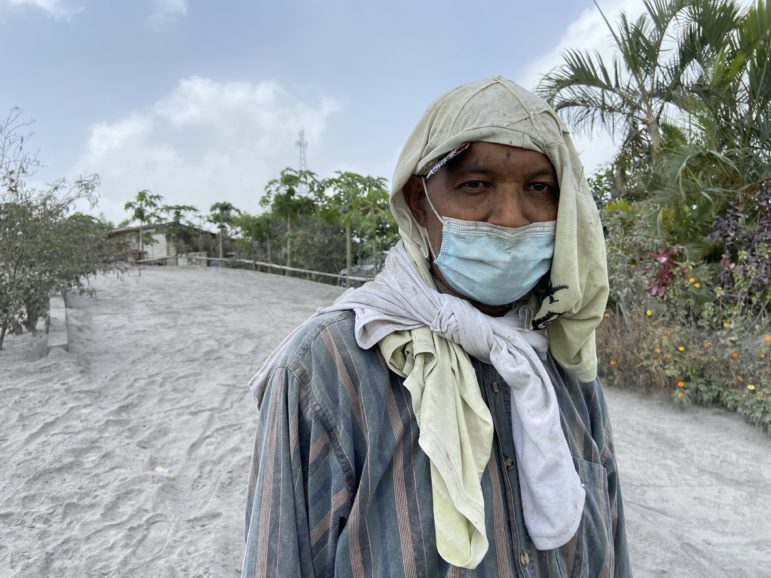
Interview: Lennox Lampkin
He is also willing to fill the gap by planting short crops – vegetables and root crops.
“If we learn the lessons from this, we can come out on top. If we don’t, we can be in trouble,” Lampkin says.
Videos and photographs by Kenton X. Chance
